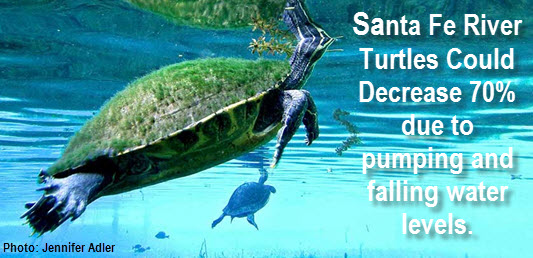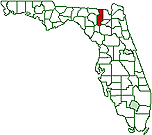Santa Fe River Turtles: Environment in Peril
Posted September 22, 2019 09:45 am | Op-Ed

Along 23 miles of the lower Santa Fe River are nearly 50 springs, which flow up from the limestone karst. Historically, there were lush meadows of underwater grasses on which the turtles fed. In recent years, over-pumping and too much nitrate pollution has caused the grasses to disappear and be replaced by algae.
 A
recent article by internationally known photographer
Jennifer Adler* shows that the
lower Santa Fe River, especially in the Gilchrist Blue
Springs area, supports one of the highest diversity of
turtles in the world. 14 native species of turtles live
in and around the Devil’s Eye Spring complex, which
includes Blue, Rum Island, Ginnie, and those adjacent to
it.
A
recent article by internationally known photographer
Jennifer Adler* shows that the
lower Santa Fe River, especially in the Gilchrist Blue
Springs area, supports one of the highest diversity of
turtles in the world. 14 native species of turtles live
in and around the Devil’s Eye Spring complex, which
includes Blue, Rum Island, Ginnie, and those adjacent to
it.
Dr. Jerry Johnston of Santa Fe College in Gainesville has spent years studying these animals and their habitant in the Santa Fe River. He has found that as algae replace grasses, turtles have to swim farther to find food — more than 100 adult females have left the river to find food 12 to 30 miles away. He predicts that the population of turtles in the lower Santa Fe River will eventually decrease by 70% if aquifer levels continue to drop.
Johnston also points out that as more water is pumped from the aquifer dissolved oxygen in the water has declined at many springs, which can affect the entire spring ecosystem, including grasses and algae.
This research comes out just as Seven Springs Water Partnership is attempting to increase and renew their water permit to pull huge amounts of water from the Devil’s Eye Spring Complex.
Perhaps it would be good for us to go to the springs and see some turtles while they are still there. We will have no clue as to how many turtles should be there since we are not turtle scientists. What we should do is listen to what scientists are telling us about them and about how the rivers are failing.
Then, informed and with this new knowledge, we have the responsibility to act and to protect the water, rivers, springs and yes, turtles that live in them.
The fact that the rivers are failing shows that our water use and our rivers are changing and consequently our entire ecosystem. What was judged to be OK in the past is not OK now if we want to continue to have healthy springs, rivers, and wildlife.
It is in the public interest for the turtles to remain in healthy springs.
To let controversial companies like Nestle take out just a little more water, so they can get richer from an unnecessary product that the public doesn’t need, is not in the public interest.
If we don’t make changes, we can be sure that Dr. Johnston’s prediction above will come true: aquifer levels will continue to drop and the turtles will leave and Nestle will be the richer and the public will be the poorer.
---------
Jim Tatum, Ph.D., spent 38 years teaching at the University of South Florida in Tampa. With two sons, three stepdaughters and nine grandchildren he has good reasons to be a watchdog of the environment. He lives on the banks of the Santa Fe River near High Springs and is a board member of Our Santa Fe River.
*Jennifer Adler's Huffing Post article |Composite Graphic by the Observer

 By
Jim Tatum
By
Jim Tatum